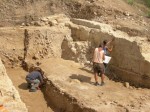 Archaeologists from the University of Torino and the ministry for Archaeology of Southern Etruria excavating the Etruscan necropolis of Tarquinia have uncovered a large, possibly royal tomb from the 7th century B.C. Found in a central area of the city of tombs (an area known to have been frequented by Etruscan royalty), the tomb has fragments of paint on the wall.
Archaeologists from the University of Torino and the ministry for Archaeology of Southern Etruria excavating the Etruscan necropolis of Tarquinia have uncovered a large, possibly royal tomb from the 7th century B.C. Found in a central area of the city of tombs (an area known to have been frequented by Etruscan royalty), the tomb has fragments of paint on the wall.
Tests on the paint indicate it was made using an ancient Greek technique invented between the mid-8th and 7th centuries B.C. The tempera-like process is the oldest known paint making technique described in historical records. If the date on the tomb is confirmed, the band of red around the entranceway of the Tarquinia tomb will be the oldest Etruscan funerary painting ever found, beating the previous record-holder by several decades.
That’s not the only significant discovery. The tomb’s design and decoration use techniques from all over the Mediterranean.
The first stage of the excavation revealed a wide, imposing, open-air staircase leading down to the crypt’s entrance. After entering the tomb, archaeologists discovered the walls were covered in a form of gypsum plaster, using techniques common in the ancient civilisations of modern-day Cyprus, Egypt and Syria. This is the first example of this technique found in the central Italian region of Etruria and is believed to have been created by specialists from the eastern Mediterranean area. This theory is further backed up by the design of the crypt itself, which appears to be modelled on a style common in Cyprus, particularly in the ancient city-state of Salamis. The fact a royal tomb was created by a team of foreign architects and craftsmen is strong evidence of a solid network of ties and trade with other cultures, archaeologists said.
Etruscans are known to have traded extensively with the Greeks, but to see evidence of cultural influences from so many different places so early is a new puzzle piece in the little we know of the Etruscan civilization. Necropoli of tombs carved into the volcanic rock of central Italy are the source of most of what we have been able to learn about them, but even there we find a mystery at every turn.
There’s a black image outlined in red above the door and archaeologists have no idea what it means. It may be an animal representing the underworld, it may mean something else entirely.